Fringe-toed lizard
Fringe-toed lizards are lizards of the genus Uma in the family Phrynosomatidae, native to deserts of North America. They are adapted for life in sandy deserts with fringe-like scales on their hind toes hence their common name.
| Fringe-toed lizard | |
|---|---|
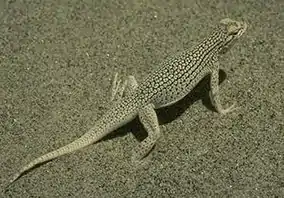 | |
| Coachella Valley fringe-toed lizard, Uma inornata | |
| Scientific classification | |
| Domain: | Eukaryota |
| Kingdom: | Animalia |
| Phylum: | Chordata |
| Class: | Reptilia |
| Order: | Squamata |
| Suborder: | Iguania |
| Family: | Phrynosomatidae |
| Genus: | Uma Baird, 1859[1] |
Descriptions
Lizards of the genus Uma have a brown and tan coloration that helps them to blend in with the sand. The dorsal surface has a velvety texture with intricate markings. In addition, they also have prominent elongated scales which form a fringe on the sides of their hind toes.[2] These fringes aid with traction and speed, and help the lizard avoid sinking into loose, sandy dunes.[3]
Fringe-toed lizards also possess upper jaws which overlap the lower ones, preventing the intrusion of sand particles, and nostrils that can be closed at will. Flaps also close against the ear openings when moving through sand, and the upper and lower eyelids have interlocking scales that prevent sand from getting into the eyes.[2]
Geographic range
Fringe-toed lizards range throughout southeast California and southwest Arizona, and extend into northwest Sonora and northeast Baja California.[2]
Habitat
Lizards of the genus Uma are found in low desert areas having fine, loose sand.
Diet
Fringe-toed lizards primarily eat insects, including ants, beetles, grasshoppers, and caterpillars. Flower buds, stems, leaves and seeds of plants are also eaten.[2]
Behavior
Lizards of the genus Uma bury themselves underground in the winter. They sleep in their burrows, and use their burrows for protection from predators and extreme temperatures.
Species
| Image | Common Name | Scientific Name | Distribution |
|---|---|---|---|
 | Coachella Valley fringe-toed lizard | Uma inornata Cope, 1895 | Coachella Valley, Riverside County, California |
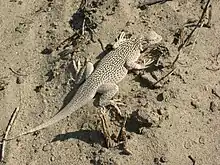 | Colorado Desert fringe-toed lizard | Uma notata Baird, 1858 | Imperial County, California to Sonora, Mexico. |
 | Mohawk Dunes fringe-toed lizard | Uma thurmanae Derycke, Gottscho, Mulcahy, & De Queiroz, 2020 | southern Arizona. |
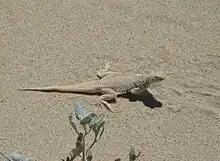 | Mojave fringe-toed lizard | Uma scoparia Cope, 1894 | California to western Arizona |
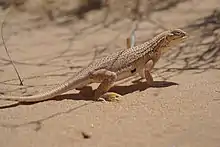 | Yuman Desert fringe-toed lizard | Uma cowlesi Heifetz, 1941 | northwestern Mexico |
| Chihuahuan fringe-toed lizard | Uma paraphygas K.L. Williams, Chrapliwy & H.M. Smith, 1959 | Mexico. | |
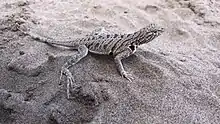 | Fringe-toed sand lizard | Uma exsul Schmidt & Bogert, 1947[4] | Mexico. |
"Uma rufopunctata", the previous name for the Yuman Desert fringe-toed lizard, was found in 2016 to represent a hybrid between U. notata and U. cowlesi.[5] ||
See also
References
- "Uma ". Wikispecies
- Stebbins, Robert C. (2003). A Field Guide to Western Reptiles and Amphibians, Third Edition. Boston and New York: Houghton Mifflin. pp. 280–282. ISBN 0395982723.
- Carothers JH (1986). "An experimental confirmation of morphological adaptation: toe fringes in the sand-dwelling lizard Uma scoparia". Evolution. 40 (4): 871–874. doi:10.2307/2408475. JSTOR 2408475. PMID 28556153.
- "Uma ". The Reptile Database. www.reptile-database.org.
- Gottscho, Andrew D.; Wood, Dustin A.; Vandergast, Amy G.; Lemos-Espinal, Julio; Gatesy, John; Reeder, Tod W. (2017-01-01). "Lineage diversification of fringe-toed lizards (Phrynosomatidae: Uma notata complex) in the Colorado Desert: Delimiting species in the presence of gene flow". Molecular Phylogenetics and Evolution. 106: 103–117. doi:10.1016/j.ympev.2016.09.008. ISSN 1055-7903. PMID 27640953.